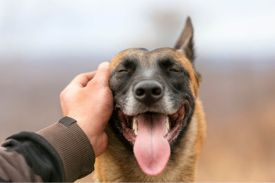Do you ever wonder why your beloved furry friend unleashes a haunting melody into the night? Dogs have been howling for centuries, connecting us to their ancestral roots when they roamed in packs. It’s an age-old tradition that continues to puzzle and captivate us.
But fear not, dear reader, for I am here to illuminate this enigmatic behavior. From communication and social bonding to expressing emotions, dogs howl for many reasons. Perhaps your puppy responds to sirens or other noises that trigger their instincts. Or maybe they seek attention and interaction from you, their adoring companion.
In some cases, medical or physical issues may be the culprit behind their soulful serenades. Breed and genetic factors can also influence this melodious habit and environmental influences that shape their behavior.
Fear not! By understanding why dogs howl, we can better serve them by providing the love and care they deserve. So let’s embark on this enlightening journey together!
Key Takeaways
- Dogs howl to communicate and strengthen social bonds with other dogs and humans.
- Howling is an ancestral instinct passed down from their wolf ancestors.
- Dogs howl to express emotions such as loneliness, anxiety, or joy.
- Howling can be a territorial or protective behavior, signaling aggression and dominance.
Communication and Social Bonding

Do you ever wonder why your furry friend howls? Dogs howl to communicate and strengthen their social bonds with other dogs and even with you!
You see, dogs are highly social creatures who rely on communication signals to interact with each other. Howling is one of these signals that they use to convey messages to their pack members. It’s like a group call that helps them stay connected and coordinate activities.
When your dog howls, they try to get your attention and invite you to join the bonding experience. You show them you’re also part of their pack by responding or joining in.
So next time your pup lets out a howl, remember it’s their way of saying, ‘Let’s stick together!’
Ancestral Instincts

An interesting statistic reveals howling is an ancestral instinct deeply ingrained in canines. It’s a natural behavior passed down through generations, dating back to their wolf ancestors.
Dogs have a strong pack mentality, and howling serves as a way for them to communicate with other members of their pack. Here are three reasons why dogs howl:
- Bonding: Howling helps dogs strengthen their social bonds with other members of their pack, creating a sense of unity and belonging.
- Territory marking: By howling, dogs assert their presence and mark their territory, letting other animals know they’re there.
- Instinctual response: Howling is an instinctual behavior for dogs. They may howl in response to certain sounds or triggers, such as sirens, music, or even the sound of another dog’s howl.
By understanding these instincts and behaviors behind why dogs howl, we can better appreciate and respond to our furry friends’ communication needs.
Expressing Emotions

Feel the raw intensity of your canine companion’s emotions as they express themselves through powerful and hauntingly beautiful howls. Dogs can remarkably communicate their feelings through vocalizations, and howling is how they do it.
When your dog howls, they provide emotional cues to help you understand what they’re experiencing. It’s their way of expressing loneliness, anxiety, or even joy. Howling triggers can vary from sirens and other dogs’ howls to separation from their loved ones or even a desire for attention.
By listening attentively to these expressive sounds, you can better serve and support your furry friend, providing them with the care and comfort they need during these emotionally charged moments.
Responding to Sirens and Other Noises
Caught off guard by the sudden blaring of sirens, your furry friend’s ears perk up, and their head tilts in curiosity. Dogs have an incredible sense of hearing, which allows them to pick up on sounds that humans may not even notice.
This includes music and fireworks. When dogs hear certain types of music, they can be drawn to it or start howling along with the melody. It’s as if they’re expressing their musical appreciation!
Similarly, when it comes to fireworks, the loud bangs and explosions can startle dogs and trigger a howl in response. It’s their way of communicating or releasing their anxiety caused by the unexpected noise. So next time you see your dog howling at a siren or during a firework show, remember that they’re uniquely responding to the world around them.
Seeking Attention or Interaction
When you see your furry friend eagerly nudging your hand with their wet nose and wagging their tail, it’s a clear sign that they are seeking your attention or craving some interaction.
Dogs are social animals and thrive on human companionship. They may howl to get your attention when they feel lonely or bored. They hope to engage you in playtime or enjoy your company by howling.
It’s important to remember that dogs rely on us for love and companionship, so giving them the attention they seek is crucial for their well-being.
Spending quality time together, playing games, going for walks, or even just cuddling can satisfy their need for interaction and help prevent feelings of loneliness.
| Attention Seeking | Loneliness | Interaction |
|---|---|---|
| Nudging | Boredom | Playtime |
| Tail wagging | Isolation | Companionship |
| Howling | Emptiness | Quality time |
Territorial or Protective Behavior
Their barking can gently remind them that they’re fiercely guarding their territory and protecting their loved ones. Dogs howl to show aggression and dominance, as well as to establish their pack mentality and hierarchy. When your furry friend howls, it’s their way of saying, “I’m the protector of this space.”
Here are a few reasons why dogs howl for territorial or protective behavior:
- To ward off potential threats: Howling is a dog’s warning signal to let intruders know that they’re entering forbidden territory.
- To communicate with other dogs: Howling is a means of communication between dogs in the same pack, establishing dominance and reinforcing social bonds.
- To mark their territory: By howling, dogs claim ownership over their surroundings, making it clear that this area belongs to them.
- To rally the pack: Dogs may also howl to gather fellow pack members for protection or hunting purposes.
By understanding these behaviors, you can better support your loyal companion in fulfilling their instincts while ensuring harmony within your household.
Medical or Physical Issues
If your furry friend is experiencing medical or physical issues, they may resort to howling to express their discomfort and seek your attention. Dogs cannot verbally communicate their pain, so they rely on vocalizations, such as howling, to convey their distress.
Some common medical conditions that can cause dogs to howl include injuries, arthritis, dental problems, and gastrointestinal issues. Additionally, certain vocalization disorders can also lead to excessive howling.
Pay attention to the frequency and intensity of your dog’s howling, which could indicate a more serious underlying issue. If you notice any changes in their behavior or if the howling becomes persistent, it’s essential to consult with a veterinarian for proper diagnosis and treatment.
To understand the emotions behind your dog’s distress, take a look at this table:
| Emotion | Description |
|---|---|
| Pain | Vocalizing due to physical discomfort |
| Anxiety | Howling out of fear or uneasiness |
| Loneliness | Expressing longing for companionship |
Addressing any medical or physical issues promptly and providing appropriate care and comfort can help alleviate your dog’s need for excessive howling and improve their overall well-being.
Breed and Genetic Factors
Certain breeds and genetic factors can contribute to excessive howling in dogs, revealing the complex interplay between nature and nurture in their vocalization tendencies. Regarding selective breeding, some breeds have been bred for specific traits that make them more prone to howling.
For example, huskies were bred for sled-pulling, and their howling helped communicate with their human companions over long distances. With their incredible sense of smell, beagles were selectively bred to bay or howl to alert hunters of their findings.
Bloodhounds were similarly generated for tracking scents, and their distinctive howl is a way to signal that they have found something of interest. Alaskan Malamutes, strong and independent dogs used by native tribes for transportation, relied on howling for crucial communication within the pack.
Understanding these hereditary traits can help dog owners better appreciate and manage their furry friends’ vocal tendencies.
Environmental Influences
Explore the fascinating ways your dog’s surroundings can shape their vocalization patterns. Howling, as a response to natural phenomena, is one-way dogs communicate with their environment.
For example, they may instinctively join in and howl when they hear sirens or other high-pitched sounds. Dogs are also influenced by different outdoor environments when it comes to howling.
In open spaces like parks or fields, they might be more inclined to let out long and melodious howls that echo through the area. On the other hand, in dense urban areas with tall buildings and crowded streets, their cries may be shorter and less pronounced due to the limited space and noise pollution.
So next time you hear your dog howl, remember that their surroundings significantly shape their unique vocalization patterns.
Training and Behavior Modification Techniques
Mastering effective training and behavior modification techniques can transform your dog’s vocalization patterns, allowing you to create a harmonious environment that you and your furry friend will appreciate.
Here are three key techniques that can help you achieve this:
- Positive reinforcement: Reward your dog with treats, praise, or playtime when they remain calm instead of howling. This will encourage them to associate silence with positive experiences.
- Desensitization: Gradually expose your dog to the triggers that usually make them howl, such as sirens or other dogs barking, in a controlled and safe manner. Start with low-intensity versions and gradually increase the exposure over time, rewarding your dog for remaining calm.
- Counterconditioning: Pair the trigger that causes your dog to howl with something positive, like their favorite toy or a tasty treat. This helps them form new associations and reduces their urge to howl.
By implementing these techniques consistently and patiently, you can help your dog learn alternative behaviors and reduce excessive howling through positive reinforcement, desensitization, and counterconditioning methods.
Frequently Asked Questions
Can dogs howl in response to music or certain sounds?
Yes, dogs can howl in response to music or certain sounds. They have a keen sense of hearing and may be drawn to specific melodies or frequencies. It’s their way of expressing emotions and joining in on the auditory experience.
Are there certain breeds that are more prone to howling than others?
Certain breeds, such as Huskies and Beagles, are more prone to howling. This behavior can result from their genetic predisposition or their instincts. Dogs may also howl at sirens and loud noises due to their heightened hearing abilities.
Can howling be a sign of a health issue in dogs?
Howling in dogs can be an effective form of communication. It may indicate normal behavior or an underlying health issue. Understanding this can help you serve your furry friend better and ensure their well-being.
Is howling more common in certain environments or living situations?
When dogs are in the presence of other dogs, they are more likely to howl. The size of the group can influence this behavior. Additionally, living in a rural area may increase a dog’s tendency to howl compared to living in an urban area.
Can howling be a learned behavior that dogs pick up from other dogs?
Yes, howling can be a learned behavior that dogs pick up from other dogs. It is a form of social communication for them. They learn by observing and imitating other dogs in their environment.
Conclusion
The resonating chorus of a dog’s howl, from primal instinct to communication, is deeply woven into their canine fabric. At Bone Voyage Dog Rescue, we understand this and much more about our furry friends. As you’ve delved into the fascinating reasons behind your dog’s howls, we hope you feel closer to understanding their rich, complex world.
Are you ready to hear a symphony of howls and other joyful noises fill your home? Open your heart and your home to one of our rescue dogs. They’re waiting to share their tales, howls, and, most importantly, their love.
Step into this journey with Bone Voyage Dog Rescue – because every howl is a song, and every dog deserves to have theirs heard. Adopt today, and let the harmonious melody of companionship begin.
